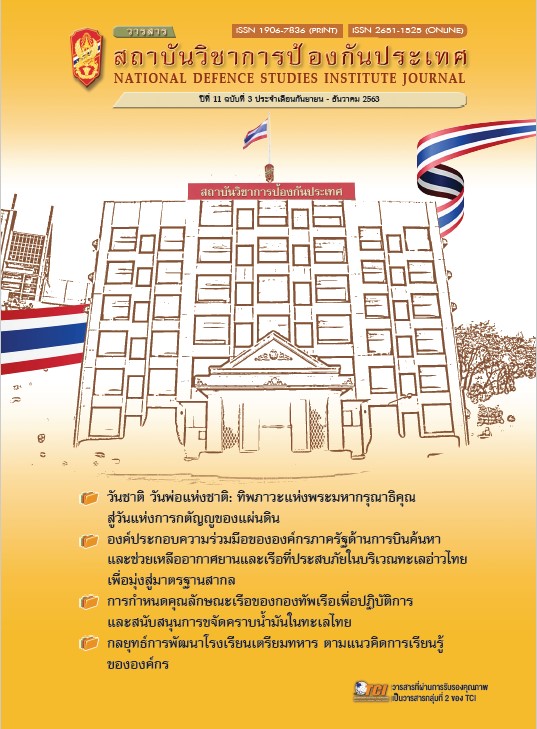Strategy for the Development of the Armed Forces Academies Preparatory School Based on the Concept of Organizational Learning
Main Article Content
Abstract
This study aims at 1) studying the concept of organizational learning components of a learning organization, 2) analyzing strengths, weaknesses, opportunities, and threats of the Armed Forces Academies Preparatory School based on the concept of organizational learning in comparison to the actual conditions and the desired conditions, and 3) proposing the strategies for the development of the School as a learning organization based on the concept of the learning organization. This study employs the four-phase mixed methods approach. The population consists of 900 staff members of the School. The sample groups for the questionnaire are composed of the executives and supervisors selected by purposive sampling and general staff selected by simple random techniques. The data collection is conducted by using questionnaires, evaluation forms, and focus group discussions, while in the data analysis, descriptive statistics, which included frequency, percentage, mean, standard deviation, PNI Modified Index, and content analysis, are used.
The findings reveal that 1) the concept of organizational learning is composed of seven components: leadership in learning, learning promotion policy, learning support environment, learning culture development, shared vision learning, lifelong learning, and digital technology application learning. Learning organization has three levels, namely organizational level, group/ team level, and individual level. 2) The analysis of internal conditions indicates that leadership in learning, learning culture development, and lifelong learning bring about strengths of the school while weaknesses are found in shared vision learning, learning promotion policy, learning support environment, and digital technology application learning. External conditions, which are opportunities of the school, include policy, discipline/goodness, organization/unit while threats are society, economy, technology, and environment. 3) The strategies that will lead to development are leadership in learning, learning promotion policy, learning support environment, learning culture development, shared vision learning, lifelong learning, and digital technology application learning. The recommendations for developing a learning organization include 1) transforming learning in the digital era, 2) building leadership at all levels, 3) building commitment in team learning, and 4) creating new cultures in new contexts.
Article Details
The articles, images, tables, graphs, written content, and opinions published in this journal are solely those of the authors and do not necessarily reflect the views or positions of the National Defence Studies Institute or its academic affiliates.
References
กานต์สุดา มาฆะศิรานนท์. (2557). การพัฒนาองค์การแห่งการเรียนรู้. กรุงเทพฯ: ส.เอเซียเพรส.
กองบัญชาการกองทัพไทย, สถาบันวิชาการป้องกันประเทศ. (2559). คู่มือการประกันคุณภาพการศึกษา ระดับปริญญาตรีขึ้นไป. กรุงเทพฯ: สถาบันวิชาการป้องกันประเทศ กองบัญชาการกองทัพไทย.
จอมพงศ์ มงคลวนิช. (2556). การบริหารองค์การและบุคลากรทางการศึกษา (พิมพ์ครั้งที่ 2). กรุงเทพฯ: จุฬาลงกรณ์มหาวิทยาลัย.
ธานินทร์ เอื้ออภิธร. (2559). มนุษย์จะสร้างทักษะ-การเรียนรู้ใหม่ เพื่อรับมือ ‘ความเปลี่ยนแปลง’ ในอนาคตอย่างไร?.สืบค้นจาก https://thestandard.co/learning-for-change/
พยัต วุฒิรงค์. (2559). การบริหารทรัพยากรมนุษย์ ในทศวรรษหน้า. กรุงเทพฯ: โรงพิมพ์แห่งจุฬาลงกรณ์มหาวิทยาลัย.
รัตนะ บัวสนธ์. (2558). วิจัยเชิงคุณภาพทางการศึกษา: การสนทนากลุ่ม (พิมพ์ครั้งที่ 5). กรุงเทพฯ: แห่งจุฬาลงกรณ์มหาวิทยาลัย.
เลิศชัย สุธรรมานนท์. (2560). กลยุทธ์การบริหารทรัพยากรมนุษย์ เพื่อองค์กรยั่งยืน: Strategic Human Resource Management for Organization Sustainability. กรุงเทพฯ: โรงพิมพ์แห่งจุฬาลงกรณ์มหาวิทยาลัย.
วิรไท สันติประภพ. (2560). ปาฐกถาพิเศษ ผู้ว่าการธนาคารแห่งประเทศไทย “คณะกรรมการบริษัทกับการขับเคลื่อนประเทศไทย”. ใน การประชุมใหญ่สามัญประจำปี 2560 สมาคมส่งเสริมสถาบันกรรมการบริษัทไทย ณ ห้องบอลรูม โรงแรมแกรนด์ไฮแอท เอราวัณ วันที่ 29 พฤษภาคม 2560. สืบค้นจาก https://thaipublica.org/2017/05/veerathai-iod-29-5-2560/
สถาบันวิชาการป้องกันประเทศ, โรงเรียนเตรียมทหาร, กองสถิติและประเมินผล. (2561). ความพึงพอใจของอาจารย์ นายทหาร-นายตำรวจปกครองของโรงเรียนเหล่าทัพและโรงเรียนนายร้อยตำรวจ ที่มีต่อคุณลักษณะอันพึงประสงค์ของนักเรียนเตรียมทหาร รุ่นที่ 59 ที่สำเร็จการศึกษาจากโรงเรียนเตรียมทหาร. นครนายก: โรงเรียนเตรียมทหาร.
สถาบันวิชาการป้องกันประเทศ, โรงเรียนเตรียมทหาร. (2561). รายงานการประเมินตนเอง. นครนายก: สำนักงานประกันคุณภาพ และมาตรฐานการศึกษาทหาร กองบัญชาการโรงเรียนเตรียมทหาร.
สมศักดิ์ ดลประสิทธิ์. (2562). บรรยายพิเศษ เรื่อง ยุทธศาสตร์ชาติ แผนการศึกษาแห่งชาติ แผนปฏิรูปประเทศด้านการศึกษา.ในการประชุมเชิงปฏิบัติการงานประกันคุณภาพการศึกษา โรงเรียนเตรียมทหาร ประจำปี 2562 วันที่ 19 มีนาคม 2562.
สาโรช บัวศรี. (2553). “รำลึกคุณูปการ ศาสตราจารย์ ดร.สาโรช บัวศร” สถาบันวัฒนธรรมและศิลปะ มหาวิทยาลัยศรีนครินทรวิโรฒ. กรุงเทพฯ: สันติศิริการพิมพ์.
สุวิทย์ เมษินทรีย์. (2561). โมเดลประเทศไทย 4.0' ผลึกความคิด. สืบค้นจาก http://www.thansettakij.com/content/9309
สุวิมล ว่องวาณิช. (2558). การวิจัยประเมินความต้องการจำเป็น (พิมพ์ครั้งที่ 3). กรุงเทพฯ: โรงพิมพ์แห่งจุฬาลงกรณ์มหาวิทยาลัย.
แอรอน เบนาวอท และคณะ. (2559). รายงานการติดตามผลการศึกษาทั่วโลก (GEM) ปี 2559. สืบค้นเมื่อ 26 กันยายน 2561, จาก https://www.gcedclearinghouse.org/sites/default/files/resources/245745tha.pdf
Basten D., and Haamann, T. (2018). Approaches for Organizational Learning: A Literature Review.SAGE-Open, (July-September), 1-20.
Dekoulou P., and Trivellas, P. (2015). Measuring the Impact of Learning Organization on Job Satisfaction and Individual Performance in Greek Advertising Sector. Procedia-Social and Behavioral Sciences, 175, 367-375.
Fuller A., and Unwin, L. (2018). Workplace Learning and the Organization. Retrieved July 11, 2020,from http://www.Research gate.Net/publication/286197843. p.49.
Gavin David, A. (1993). Building a learning organization. Harvard Business Review, 71(4), 78.
Gilaninia, S., Rankouh, A.A.A., and Gildeh, M. A. (2013). Overview on the Importance of Organizational Learning and Learning Organization. Journal of Research and Development, 1(2), 44-49.
Rovinelli, R.J., and Hambleton, R, K. (1977). On the use of content specialists in the assessment of criterion-referenced test item validity. Dutch Journal of Educational Research, 2, 49-60.
Saadat, V., and Saadat, Z. (2016). Organizational Learning as a Key Role of Organizational Success. Social and Behavioural Sciences, 230, 219-225. Retrieved from www.sciencedirect.com
Turner, R.C., and Carlson, L.A. (2003). Indexes of Item-Objective Congruence for Multidimensional Items. International Journal of Testing, 3(2). Retrieved from https://www.researchgate.net/publication/ 247502723_Indexes_of_Item-Objective_Congruence_for_Multidimensional_Items
Turner, R.C., et al. (2002). Computing Indices of Item Congruence for Test Development Validity Assessments. Statistics and Data Analysis. Retrieved from http://www2.sas.com/proceedings/sugi27/p255-27.pdf
Yamane, T. (1973). Statistics: An Introductory Analysis (3th ed.). New York: Harper and Row Publication.
Yulk, G. (2002). Leadership in organizations (4th ed.). New Jersey: Prentice-Hall.


